Using Text Features to Gather Evidence About Soil Transcript
Teacher: Tita Galde
Teacher [in class]: What are we talking about today? Who remembers? Use your genius brain. Louis?
Student: We're talking about soil.
Teacher [in interview]: Hi, my name is Tita Galde and I would like to invite you to join myself and my second graders in gathering evidence about soil using our common core practices.
Teacher [in interview]: This lesson was put together - we started out to say, "what is it that we can do to teach students about soil?" Which is one of the science standards.
Teacher [in class]: All right, boys and girls, today - for language arts - we're going to be doing two things. In language arts, you've been taking notes. You've been taking notes about rocks... what else?
Students: Minerals. Fossils.
Teacher [in class]: That's right. And today, it's about soil. Yesterday, you learned something. When we looked in your book, you learned about some text...
Students: Features.
Teacher [in class]: That's right. Here are some of those text features.
Teacher [in interview]: Today's lesson was reviewing text features but also taking notes from informational texts with multiple sources. At the end of the lesson, they would be able to reflect on learned - what they gathered. And have the students be able to compile their thoughts with their notes from the text.
+++ 00:01:32.03 +++
Student: I know that animals, insects and worms is in the soil.
Teacher [in interview]: The Common Core Standard was to see if they could ask and answer questions and our topic was soil.
Students: Soil.
Teacher [in class]: It is soil. Yes, Audrey?
Student: We are talking about soil.
Teacher [in class]: Our topic will be about soil. And also we're focusing on...
Students: Text features.
Teacher [in class]: Text are...
Students: Words.
Teacher [in class]: And features are...
Students: Parts.
Teacher [in class]: And we listed many features, however, today I'm going to ask you to stand up - yeah, stand up - in a moment, you'll be going back to your seats. We'll use overhead projector so that you can learn more about soil but we're going to be using our text features. There's three. Does anybody remember what they were? How about you, Daisy?
Student: Bold words?
Teacher [in class]: Bold words. That's right. Words that are in different print. Estella?
Student: Headings? And sub-headings?
Teacher [in class]: That's right. Uh-huh?
Student: Diagrams?
Teacher [in class]: Diagrams. I'm glad you remembered because, remember you made your brain stronger when you try to remember things.
Teacher [in interview]: The shift, for me, in the common core is that I used to have them read and answer questions - just, basic - and now I really am looking at text features. That gives them an overview of what they're going to be learning. Then they could dig deeper. So that was a big shift. It used to be superficial but now it's - for me, that's what I'm learning to do.
Teacher [in class]: All right, everybody, let's look up at the screen. Can you read that?
Students: Soil layers.
Teacher [in class]: That's right.
+++ 00:03:11.17 +++
Teacher [in class]: There's a lot of text. Right? There's also... what else do you notice? Any headings? Sub-headings? You see anything? Yes, Louis?
Student: What are the big letters for?
Teacher [in class]: Louis asked a really good question. What are the big letters for?
Student: The big letters are for - so it could talk about what it's about?
Teacher [in interview]: I need to be able to - from right now, for them to understand how important the text is. It's not just about fluency and comprehension isn't just about reading and spitting out. It's really looking at the whole picture of what the text is about.
Teacher [in class]: You, as second graders - in order for you to read really a lot better - to really comprehend, you need to know how to look at the information you're given. All right, everybody, let's look at the screen.
Teacher [in interview]: You notice, we didn't read everything because it wasn't about reading everything, it was about focusing on the text features and being able to find some evidence by rereading so we just started. We'll continue tomorrow.
Teacher [in class]: Pass this out to everybody here, please. Right now, this will be guided. That means that I am showing you. I am helping you to do this first part right now and for this, you're going to need a template.
Teacher [in interview]: And the template had some questions with spaces for them to write the evidence that they gathered. Evidence. I use that word a lot so that they can make it part of their vocabulary.
Teacher [in class]: Let's look at the first question. Key words. What was one of the key words?
Student: Repeat.
Teacher [in class]: What repeats? Esteban?
Student: Soil?
Teacher [in class]: Soil! Can you write soil in the first one? What word repeats?
+++ 00:05:02.21 +++
Teacher [in interview]: So they need to fill in information - evidence - that they had gathered from either text and later, what was in their science book.
Teacher [in class]: Okay, s let's look at the texts that you have. You have this text, right? So you have a questions, what was that question, Anthony? What covers most of the earth?
Student: What covers most of the earth? Soil.
Teacher [in class]: Ok. Who has an answer for that? You do Marianna, what is it?
Student: Soil?
Teacher [in class]: Ok, let's look for the evidence.
Teacher [in interview]: One of the shifts for me in common core is to find evidence throughout.
Teacher [in class]: Let's read the first sentence. "Soil covers much of the land on the earth." So if you wrote soil in the first box, then you're right because here it is.
Teacher [in interview]: Evidence - not just in language arts - not just in the text, but also in math and in science.
Teacher [in class]: Look it - I have evidence here. It's made up of rock, sand, clays. Look it! It is even made up of air. Water. Who said water? Look at that. It's right here. Here is your evidence and organic material. Material from matter from dead plants and animals. So, what is soil made of?
Student: Animals? Water? Air?
Teacher [in class]: There you go. Here's your evidence. You can highlight that. When you highlight, you are bolding information your own selves. Show me your evidence.
+++ 00:06:33.10 +++
Student: "Who lives in the soil?"
Teacher [in class]: So, let's go back. "Who lives in the soil?" I saw the word, "home."
Student: Home?
Teacher [in class]: Isn't that a place where somebody lives? Keep reading.
Student: "For many animals. Animals. Insects, spiders, centipedes, worms, burrowing animals, bacteria and many others."
Teacher [in class]: So, there's your evidence. Did you see where your evidence of who lives there?
Teacher [in interview]: We did not go through the entire template. We only went through a few, like words. Always very important. I looked around and I thought, they're read to go on by themselves then we made a shift.
Teacher [in class]: We're going to be using this book and in here are some - there's chapter about what? What do you think?
Students: Soil!
Teacher [in class]: Soil! That's right. I need you to come back to the carpet with me, please.
+++ 00:07:47.02 +++
Teacher [in interview]: We transitioned from our desks to the carpet using the science book with the template so that next part was for them to say, ok, we've practiced. We've been taking notes. Now, let's see. Can we go back and find evidence in our reading to answer these questions?
Teacher [in class]: All right, everybody. Let's start with your key words, over here. Do you have your keyboard? Caleb? Ok, great. Key words? Do you have any words repeating? Yes?
Student: Soil?
Teacher [in class]: Ok.
Student: Rocks.
Teacher [in class]: Write those down in the first one. Do you see something else?
Student: Silt.
Teacher [in class]: Silt! Look it! Silt, silt, that repeats. Yes?
Student: Minerals?
Teacher [in class]: Minerals? I saw it once. Derek?
Student: Clay?
Teacher [in class]: Yeah, it repeated more than once. What else is in soil? Yes?
Student: When plants and animals die, they become part of the soil.
Teacher [in class]: Ok, so there you go. What's in soil? What's in soil, Louis?
Student: Plants and animals.
Teacher [in class]: What else, Anthony?
Student: Worms.
Teacher [in class]: Next, we went from the rug back to the desks for a ten minute quick break. What is it that you learned about soil? Three or more quick facts. Ten minutes.
Teacher [in class]: Your pencil is flying off that page!
Teacher [in interview]: And before time was up, some were ready to share.
Student: Who would like to share what they wrote about soil? Louis.
Student: Soil is dirt. Animals and plants die and in the soil. So it is rocks, soil. Soil is water. Soil is soil.
Student: Anthony.
Student: Soil is rocks. Water dried. Soil is sand and... dirt.
Teacher [in interview]: We're a school and they're going to be citizens. I don't know where they're going to end up, but I hope that they'll remember something from this classroom. And one of the things I hope that they remember is that they learned a lot because they had a teacher that really cared about them and a teacher that provided an opportunity for their voice to be heard.

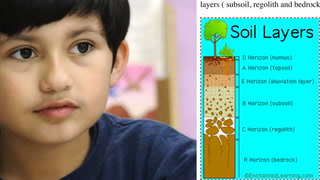
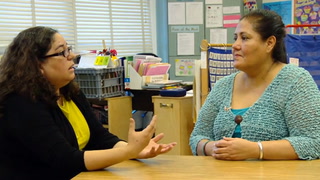

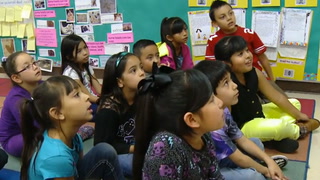
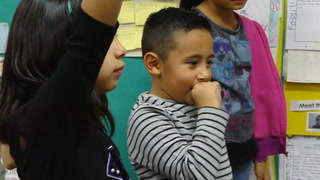
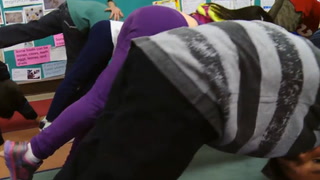








17 Comments
Andy Franco Oct 17, 2018 3:58pm
I LOVE how she encourages children to use the microphone to share and how students invite their peers up to speak from the carpet. Very inspiring! :'))
George Shenouda Jul 15, 2017 2:26pm
ligia ampie Apr 18, 2017 10:39pm
Beth Torres Apr 5, 2017 7:01pm
Shannon Glazier Nov 7, 2016 12:42pm